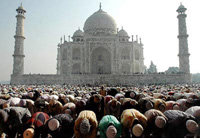 |
|
The Taj Mahal was
built to express an emperor's love for his
wife | |
The Taj Mahal is to open on moonlit evenings 20 years after
security fears ended night visits.
India's Supreme Court will allow the famous monument to love to open
four nights a month, initially for three months.
The Taj, built in the 1600s by the Mughal emperor Shah Jahan as a
shrine for his wife, is a World Heritage site.
Only 400 visitors will be let in each night, and parking restrictions
will be imposed around the marble mausoleum.
The Supreme Court announcement came as state officials in Uttar Pradesh
were celebrating the Taj's 350th anniversary close to its site in the city
of Agra.
State tourism minister Kaukab Hamid described the ruling as
"heartening".
"This reopening of the Taj for moonlight viewing is going to draw
fantastic crowds from across the globe," he said.
"We will ensure strict security and follow visitor guidelines laid down
by the Supreme Court."
Tourist chiefs said more than 300,000 foreigners visited the Taj Mahal
site in 2003, but numbers are down since the terror attacks in the US on
11 September 2001.
Night visits to the Taj, once a romantic highlight of any visit to India,
were banned in 1984 amid fears that militant Sikhs battling the government
would attack the shrine.
The Sikh insurgency ended in the mid-1990s, but Indian authorities have
remained reluctant to let visitors back to the Taj after sunset.
During the height of tensions between India and Pakistan in 2001,
officials drew up plans to camouflage the Taj to disguise it from possible
Pakistani air attacks.
There were also fears that a militant Kashmiri separatist group,
Laskhar-e-Toiba, was planning to try and blow up the shrine.
Shah Jahan built the Taj Mahal as an expression of love for his wife
Mumtaz Mahal.
Situated on the banks of River Yamuna, the shrine is largely made of
white marble that reflects the changes of colour visible during sunset and
clear, moonlit nights.
It was designated as a Unesco World Heritage site in 1983, meaning the
Indian Supreme Court must rule on major works or changes likely to impact
on the site.
(Agencies) |
印度泰姬陵即將在月光照耀的夜晚(對游人)開放。20年前,出于安全考慮,泰姬陵取消了晚間觀光活動。
印度最高法院將允許這座著名的“愛情紀念物”每月有四天在夜間開放,初步決定試行三個月。
世界遺產泰姬陵是17世紀印度莫臥兒王朝的皇帝沙賈汗為愛妻修建的陵墓。
每晚只有400名游客有機會入內參觀,大理石陵墓周圍還將強制執行停車管制。
印度最高法院的法令出臺前不久,印度北方邦的官員們在位于阿格拉市的陵墓附近為泰姬陵落成350周年舉行了慶祝紀念活動。
國家旅游部長考卡布·哈米德稱這一決定是“令人振奮的”。
“泰姬陵在月明之夜重新開放將會吸引來自世界各地的人們,屆時游客數量將是驚人的。”他說。
“我們將嚴格確保泰姬陵的安全,遵守最高法院發布的觀光游覽守則。”
旅游部門的負責人說,2003年總共有30多萬外國游客前來參觀泰姬陵,但自2001年美國發生9/11恐怖襲擊事件后,游客數量與以前相比還是有所下降。
夜游泰姬陵曾是印度之旅中一個精彩浪漫的亮點,但在1984年,印度政府由于擔心泰姬陵遭到反政府武裝錫克教的襲擊,下令禁止在夜間參觀泰姬陵。
上世紀90年代中期,錫克教叛亂被平定,但是印度當局仍然不愿意讓游客在日落之后重返泰姬陵。
2001年,印度和巴基斯坦之間的緊張局面發展到頂點,印度官方甚至草擬了偽裝泰姬陵的計劃,以應對巴基斯坦可能進行的空襲。
同時還有對克什米爾武裝分裂組織Laskhar-e-Toiba的擔心,該武裝組織曾計劃炸毀泰姬陵。
印度皇帝沙賈汗修建泰姬陵,是為了表達他對亡妻泰姬·瑪哈爾的深愛。
這座坐落在亞穆納河岸邊的陵墓主要由白色大理石建成,在日落的黃昏和月光皎潔的夜晚,大理石能夠折射出變幻的顏色。
1983年,聯合國教科文組織將它定為世界文化遺產。這就意味著印度最高法院必須出臺相應措施來管制那些可能會對陵墓產生影響的主要活動和變化。
(中國日報網站譯) |
